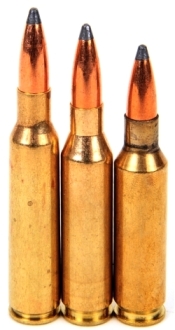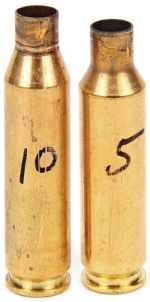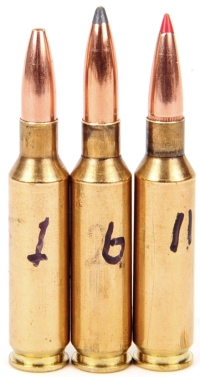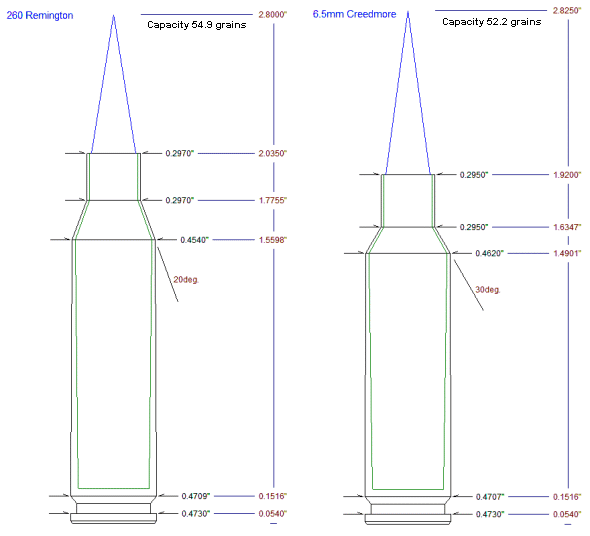These days, firearms seem to exist in two parallel worlds… sort of like Superman and Mr. Mxyzptlk. The first is reality, the second is Internet blather. No, I am not saying that there aren’t credible people posting to message boards and Facebook, but I am saying that 50% of the most vocal are consensus seeking parrots who have never seen, much less experienced, the firearm that is the subject of their rabid criticism. Too subtle? Case in point the 6.5 Creedmoor, below far right, which is next to the 260 Remington, which is next to the 6.5×55 Swede.

Whenever we mention the 6.5 Creedmoor, we always receive angry email from a handful of folks who demand that we accept the 260 Remington’s superiority. I’m never sure if these folks think these cartridges are running for political office and need their support or perhaps they are a fantasy sports team that demands fan support. Do they lose money if their favorite cartridge isn’t selected? Will their hair fall out? Cartridges are little machines… Mechanical devices, propelled by a chemical reaction. They have no family, they have no friends they have no emotional or intellectual component. If you love them, they will not love you back, If you set them free, they will fall to the ground, they will not fly away.
Fortunately, because cartridges are simple machines, they can be measured in virtually every respect, which means their performance is easy to assess under controlled conditions. No, field performance assessment is not better than lab assessment. Field performance is at best anecdotal, more typically conjecture, and most often a measurement of the shooter’s skills rather than the firearm or cartridge. This is particularly the case with the 6.5 Creedmoor where its intended benefits are nuance evolutionary and not revolutionary. So I took some time to take a closer look.
The 6.5 Creedmoor was designed in 2007 by Hornady’s Senior Ballistics Scientist, Dave Emery and Dennis Demille, GM of Creedmoor Sports. It was, according to the current Hornady reloading manual, designed specifically for short action firearms. Its short case length results in long 6.5mm bullets displacing less case volume than might be the case with the 6.5×284 or 260 Remington. The Creedmoor is not billed as a blazing fast round or big game slayer, but rather a cartridge that offers a little more latitude to a competitive shooter and it is often defined as being inherently accurate. However, there is almost always more to the accuracy story than case form or aspect ratio. The Creedmoor is based loosely on the Thompson Center’s 30 TC, which is based loosely on the 308 Winchester, which is based loosely on the 30-06 Springfield. All which applies to the 260 Remington, with the exception of the 30 TC reference. Numerically speaking, the 6.5 Creedmoor and 260 Remington look as illustrated below.
Oliver and Hardy
Theoretically, because of the 6.5 Creedmoor’s longer cartridge overall length, steep shoulder angle and less tapered case, a seated bullet would displace less powder volume than it would if seated in the 260 Remington. Subsequently, the 6.5 Creedmoor’s net capacity with bullet in place would be greater. Of course that can easily be measured.
 New brass is always undersize, so once fired, full length resized brass was wet checked with distilled water; ten samples of each cartridge. Exterior dimensions were as per the illustration above and both types had 0.013″ material thickness, which qualifies this as a fair comparison.
New brass is always undersize, so once fired, full length resized brass was wet checked with distilled water; ten samples of each cartridge. Exterior dimensions were as per the illustration above and both types had 0.013″ material thickness, which qualifies this as a fair comparison.
| Wet Measurement H2O |
260 Remington |
6.5 Creedmoor |
|
Gross Capacity – Grains
|
54.3 |
52.8 |
| Net Capacity 120 Grain Sierra Match BTSP |
48.4 @ 2.800″ COL |
50.3 @ 2.825″ COL |
| Net Capacity 140 Grain Sierra Match BTSP |
46.6 @ 2.800″ COL |
48.4 @ 2.825″ COL |
| Net Capacity 120 Grain Sierra Match BTSP |
48.4 @ 2.800″ COL |
48.4 @ 2.690″ COL |
| Net Capacity 140 Grain Sierra Match BTSP |
47.1 @ 2.800″ COL |
47.9 @2.790″ COL |
| Net Capacity 140 Grain Nosler Partition FB |
46.3 @ 2.800″ COL |
48.1 @ 2.825″ COL |
| Net Capacity 155 Grain HPBT |
44.9 @ 2.800″ COL |
46.8 @ 2.825″ COL |
Conclusions? Sure. If you are shooting a rifle that does not require bullets, the 260 Remington has a clear capacity advantage. For folks who shoot competitively and aren’t worried about bullets hanging on for dear life with a 0.120″ shank seating depth, the 6.5 Creedmoor has a clear couple of grains advantage. With short bullets of 120 grains or less, the Creedmoor loses much of its advantage. Utilizing the Creedmoor’s greater overall length with bullets 140 grain or more, the Creedmoor regains its 2 grain advantage with boat tail or flat base bullets. Again, the intention of the design was to create a round that would function well in a short action with less bullet case incursion.
Joe… thanks for the nap. Is there a tangible 6.5 Creedmoor advantage?
 When adjusted for equal 60,000 PSI load levels, the capacity advantage of the Creedmoor over the 260 Remington works out to approximately a 35 FPS Creedmoor advantage from a 28″ barrel with a 140 grain bullet and a powder like Norma URP.
When adjusted for equal 60,000 PSI load levels, the capacity advantage of the Creedmoor over the 260 Remington works out to approximately a 35 FPS Creedmoor advantage from a 28″ barrel with a 140 grain bullet and a powder like Norma URP.Handloads…
Four bullets were selected for handloads. All bullets I’ve used over the years with good success in the 260 Remington, 6.5x55mm and the 264 Winchester Magnum.
| Bullet |
Weight
Grains |
Bullet
Length |
Cartridge
Length |
| Sierra Varminter #1710 HPFB |
100 |
0.933″ |
2.590″ |
| Sierra Pro Hunter # 1720SPFB |
120 |
1.085″ |
2.750″ |
| Hornady Interlock #2620 SPFB |
129 |
1.177″ |
2.690″ |
| Hornady SST Interlock #26302 SPBT |
140 |
1.395″ |
2.700″ |
All of these rounds cleared magazine and freebore, none exceeded maximum cartridge length specification.
|

|
Warning: Bullet selections are specific, and loads are not valid with substitutions of different bullets of the same weight. Variations in bullet length will alter net case capacity, pressure and velocity. Primer selection is specific and primer types are not interchangeable. These are maximum loads in my firearms and may easily be excessive in others. All loads should be reduced by 5%, and developed following safe handloading practices as represented in established reloading manuals produced by component manufacturers. Presentation of these loads does not constitute a solicitation for their use, nor a recommendation.
|
Cartridge: 6.5 Creedmoor
|
|
Rifle: Ruger M77 Mk II Target
|
Max COL: 2.825″
|
|
Bullet Diameter: 0.264″
|
Primer: CCI 200
|
|
Barrel: 28″
|
Reloading Dies: Hornady
|
|
Max case length: 1.920″
|
3 Shot Group: 100 yards
|
| – |
|
|
Bullet
|
Bullet Weight
Grains
|
Net Water Capacity
|
COL”
|
|
Powder Type
|
Powder Charge
Grains
|
Muzzle Velocity
FPS |
Muzzle Energy
Ft-Lbs
|
Group Size
3 Shot “
|
| Sierra Varminter #1710 |
100 |
49.8 |
2.590 |
|
Re17 |
47.0C |
3435 |
2621 |
0.4 |
| Sierra Varminter #1710 |
100 |
49.8 |
2.590 |
|
Norma URP |
48.0C |
3422 |
2601 |
0.2 |
| Sierra Pro Hunter # 1720 |
120 |
50.0 |
2.750 |
|
Re17 |
45.0 |
3162 |
2665 |
0.5 |
| Sierra Pro Hunter # 1720 |
120 |
50.0 |
2.750 |
|
Norma URP |
46.0 |
3157 |
2656 |
0.4 |
| Hornady Interlock #2620 |
129 |
47.9 |
2.690 |
|
H414 |
44.5 |
3046 |
2658 |
0.7 |
| Hornady Interlock #2620 |
129 |
47.9 |
2.690 |
|
Norma URP |
44.0 |
3038 |
2644 |
0.6 |
Hornady SST Interlock #26302
|
140 |
45.2 |
2.700 |
|
H414 |
42.0 |
2906 |
2626 |
0.9 |
Hornady SST Interlock #26302
|
140 |
45.2 |
2.700 |
|
Norma URP |
41.5 |
2895 |
2606 |
0.9 |
|
Are we done yet? …Sure
For the time spent on working up handloads, I believe the Ruger M77 Mark II Target has been the most accurate out of the box factory rifle I’ve worked with. No cleaning up inletting, no re-torquing barrels, no cleaning up chambers. Just playing with powder charges and types. Maybe the 6.5 Creedmoor is not for you. That’s OK, because the star of this show is the Ruger Model 77 Mark II Target Rifle which is also available in 204 Ruger, 22-250 Remington, 223 Remington, and 308 Winchester.
Ruger’s M77 Mark II Target Rifle Part 1
Ruger’s M77 Mark II Target Rifle Part 2



 New brass is always undersize, so once fired, full length resized brass was wet checked with distilled water; ten samples of each cartridge. Exterior dimensions were as per the illustration above and both types had 0.013″ material thickness, which qualifies this as a fair comparison.
New brass is always undersize, so once fired, full length resized brass was wet checked with distilled water; ten samples of each cartridge. Exterior dimensions were as per the illustration above and both types had 0.013″ material thickness, which qualifies this as a fair comparison. When adjusted for equal 60,000 PSI load levels, the capacity advantage of the Creedmoor over the 260 Remington works out to approximately a 35 FPS Creedmoor advantage from a 28″ barrel with a 140 grain bullet and a powder like Norma URP.
When adjusted for equal 60,000 PSI load levels, the capacity advantage of the Creedmoor over the 260 Remington works out to approximately a 35 FPS Creedmoor advantage from a 28″ barrel with a 140 grain bullet and a powder like Norma URP.


Email Notification